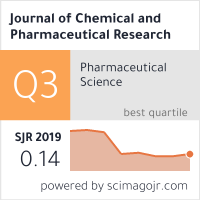Journal of Chemical and Pharmaceutical Research is an online Peer Reviewed international journal to promote all fields of Chemical Sciences like Organic Chemistry, Green Chemistry, Photochemistry, Inorganic Chemistry, Physical Chemistry, Industrial Chemistry, Biochemistry, Environmental Chemistry, Agricultural & Soil Chemistry, Analytical Chemistry, Polymer Chemistry, Macromolecular Chemistry, Petroleum Chemistry, Forensic Chemistry and Phytochemistry as well as all aspects of Chemical Engineering etc.
Journal of Chemical and Pharmaceutical Research allowing free full-text access and also devoted to the promotion of all fields of Pharmaceutical Sciences like Pharmaceutics, Pharmaceutical & Medicinal Chemistry, Pharmacology, Pharmacognosy, Pharmaceutical Analysis, Computational Chemistry & Molecular Modeling/Drug Design including Pharmacokinetics, Pharmacodynamics, Pharmacoinformatics, Pharmacovigilance, Chemoinformatics and Pharmacogenomics etc.
Journal of Chemical and Pharmaceutical Research publishes research papers, short communications, reviews and notes dealing with entire aspects of Chemical and Pharmaceutical sciences.


Fast Editorial Execution and Review Process (FEE-Review Process):
Journal of Chemical and Pharmaceutical Research is participating in the Fast Editorial Execution and Review Process (FEE-Review Process) with an additional prepayment of $99 apart from the regular article processing fee. Fast Editorial Execution and Review Process is a special service for the article that enables it to get a faster response in the pre-review stage from the handling editor as well as a review from the reviewer. An author can get a faster response of pre-review maximum in 3 days since submission, and a review process by the reviewer maximum in 5 days, followed by revision/publication in 2 days. If the article gets notified for revision by the handling editor, then it will take another 5 days for external review by the previous reviewer or alternative reviewer.
Acceptance of manuscripts is driven entirely by handling editorial team considerations and independent peer-review, ensuring the highest standards are maintained no matter the route to regular peer-reviewed publication or a fast editorial review process. The handling editor and the article contributor are responsible for adhering to scientific standards. The article FEE-Review process of $99 will not be refunded even if the article is rejected or withdrawn for publication.
The corresponding author or institution/organization is responsible for making the manuscript FEE-Review Process payment. The additional FEE-Review Process payment covers the fast review processing and quick editorial decisions, and regular article publication covers the preparation in various formats for online publication, securing full-text inclusion in a number of permanent archives like HTML, XML, and PDF, and feeding to different indexing agencies.
